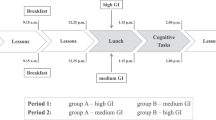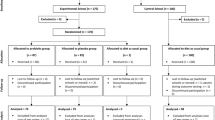Abstract
Objective: To examine effects of iron supplementation on vigilance, attention and conceptual learning in preschool children in Greece.
Design: Randomized Double-Blind Placebo Controlled trial of iron. Randomization stratified by iron status and day care center (DCC).
Setting: Nine public DCCs in Athens, Greece.
Subjects: In all, 49 3–4-y olds (21 anemic, 28 good iron status) with birth weight not less than 2500 g, currently healthy; benign past medical history, IQ ≥1 s.d. below the age-adjusted mean, serum Pb ≤200 ppb (none exceeded 50 ppb), and height, weight and head circumference for age ≥10th percentile. Anemia defined as: (1) pretreatment Hgb <112 g/l and TS <16% and ferritin <12 μg/L OR (2) Hgb rise of >10 g/l (T2–T0) with iron supplementation. Good iron status was defined as baseline levels of Hgb >120 g/l and either TS >20% or serum ferritin >12 μg/l.
Intervention: The intervention consisted of a 2–month supplementation of 15 mg iron (and MV) vs placebo (MV alone).
Results: After iron treatment, the anemic subjects made significantly fewer errors of commission (14% higher specificity, P<0.05), exhibited 8% higher accuracy (P<0.05) and were significantly more efficient (mean difference=1.09, P<0.05) than those given placebo. These effects of iron were not found among preschoolers with good iron status. No effects of iron treatment were found on the Oddity Learning task.
Conclusions: This study demonstrated that iron supplementation of iron-deficient anemic preschoolers results in an improvement in discrimination, specifically selective attention.
Sponsorship: University of California, Davis and Nutricia Corporation.
This is a preview of subscription content, access via your institution
Access options
Subscribe to this journal
Receive 12 print issues and online access
$259.00 per year
only $21.58 per issue
Buy this article
- Purchase on Springer Link
- Instant access to full article PDF
Prices may be subject to local taxes which are calculated during checkout

Similar content being viewed by others
References
Algarín C, Peirano P, Garrido M, Pizarro F & Lozoff B (2003): Iron deficiency anemia in infancy: long-lasting effects on auditory and visual system functioning. Ped. Res. 53, 217–223.
Anderson S, Auguier A, Hauck WW, Oakes D, Vandaele W & Weisberg H. (1980): Analyzing data from premeasure/postmeasure design. Statist. Methods Compar. Stud. 235–247 (Chapter 11).
Beard JL (2001): Iron biology in immune function, muscle metabolism, and neuronal functioning. J. Nutr. 131, 568S–580S.
Bruner A, Joffe A, Duggan A, Casella J & Brandt J (1996): Randomized study of cognitive effects of iron supplementation in non-anaemic iron-deficient adolescent girls. Lancet 348, 992–996.
Centers for Disease Control and Prevention (CDC) (2000): Blood lead levels in young children—United States and Selected States, 1996–1999. MMWR 49, 1133–1137.
Driva A, Kafatos A & Solman M. (1985): Iron deficiency and the cognitive and psychomotor development of children: a pilot study with institutionalised children. Early Child Dev. Care 22, 73–82.
Grantham-McGregor S & Ani C. (2001): A review of studies on the effect of iron deficiency on cognitive development in children. J. Nutr. 131, 649S–668S.
Harahap H, Jahari AB, Husaini MA, Saco-Pollitt C & Pollitt E. (2000): Effects of an energy and micronutrient supplement on iron deficiency anemia, physical activity and motor and mental development in undernourished children in Indonesia. Eur. J. Clin. Nutr. 54 (Suppl), S114–S119.
Idjradinata P & Pollitt E. (1993): Reversal of developmental delays in iron-deficient anaemic infants treated with iron. Lancet 341, 1–4.
Kattamis C. (1982): Prospects, inabilities and achievements in epidemiologic studies on iron deficiency and iron deficiency anemia. Paediatrician 11, 121–135.
Lozoff B, Klein NK, Nelson EC, McClish DK, Manuel M & Chacon ME (1998): Behavior of infants with iron deficiency anemia. Child Dev. 69, 24–36.
Lozoff B, Jimenez E, Hagen J, Mollen E & Wolf AW (2000): Poorer behavioral and developmental outcome more than 10 years after treatment for iron deficiency in infancy. J. Pediatr. 105, 1–11.
Lozoff B, De Andraca I, Castillo M, Smith JB, Walter T & Pino P (2003): Behavioral and developmental effects of preventing iron-deficiency anemia in healthy full-term infants. Pediatrics 112, 846–854.
Lynn R & Harland EP (1998): A positive effect of iron supplementation on the IQS of iron deficient children. Person Ind. Diff. 24 (6), 883–885.
Massaro TF (1982): Effect of iron deficiency in learning. In Iron Deficiency: Brain Biochemistry and Behavior eds Pollitt E, Leibel RL New York, NY: Raven Press. pp 125–140.
Neter J, Waserman W & Kutter MH (1985): Applied linear statistical models, pp 700–702. Homerwood, IL: Richard D. Irwin Inc.
Nurss J (1987): Readiness for Kindergarten. ERIC Digest: ERIC Clearinghouse on Elementary and Early Childhood Education.
Oski FA & Honig AS (1978): The effects of therapy on the developmental scores of iron-deficient infants. J. Pediat. 92, 21–25.
Pilch SM & Senti FR eds. (1984): Assessment of the Iron Nutritional Status of the US Population based on data Collected in the Second National Health and Nutrition Examination Survey, 1976–1980. Report of the Life Sciences Research Office. Bethesda, MD: Federation of American Societies for Experimental Biology.
Pollitt E (1993): Iron Deficiency and Cognitive Function. Annu. Rev. of Nutr. 13, 521–537.
Pollitt E, Leibel RL & Greenfield DB (1983): Iron deficiency and cognitive test performance in preschool children. Nutr. Behav. 1, 137–146.
Pollitt E, Saco-Pollitt C, Leibel RL & Viteri FE (1986): Iron deficiency and behavioral development in infants and preschool children. Am. J. Clin. Nutr. 43, 555–565.
Pollitt E, Gorman KE, Martorell R & Ingel P (1993): Early supplementary feeding and cognition. Monogr. Soc. Res. Child Dev. 58, 1–12.
Pollitt E (2001): The Developmental and Probabilistic nature of the functional consequences of Iron-Deficiency Anemia in Children. J. Nutr. 131, 669S–675S.
Saco-Pollitt C, Pollitt E & Greenfield DB (1985): The cumulative deficit hypothesis in the light of cross-culture evidence. Int. J. Behav. Dev. 8, 75–97.
Salkind NJ & Wright JC (1977): The development of reflection–impulsivity and cognitive efficiency. An Integrated Model. Hum. Dev. 20, 377–387.
Seshadri S & Gopaldas T (1989): Impact of iron supplementation on cognitive functions in preschool and school-aged children: the Indian experience. Am. J. Clin. Nutr. 50 (Suppl), 675–684.
Soewondo W, Husaini M & Pollitt E (1989): Effects of iron deficiency on Attention and learning processes in preschool children: Bangdung Indonesia. Am. J. Clin. Nutr. 50 (Suppl), 667–673.
United States Center for Health Statistics: NCHS Growth Charts (1976): Monthly Vital Statistics Report, Vol 25 (3) Suppl (HRA) 76-1120 Health Resources Administration, Rockville MA, June.
Walter T, Kovalskys J & Stekel A (1983): Effect of mild iron deficiency on infant mental development scores. J. Pediat. 102, 519–522.
Author information
Authors and Affiliations
Contributions
Guarantor: E Metallinos-Katsaras.
Contributors: EMK participated in all phases of the study including conception, design, clinical trail implementation, data collection, data analyses and interpretation, and manuscript preparation. EVA was the principal collaborator in Greece and was involved in site selection, subject recruitment, data collection, and manuscript revisions. EP was involved in the study conception, design, development of analytic strategies, interpretation of analyses, and manuscript revisions. KGD and BL participated in study design, interpretation of analyses, and manuscript revisions. AS conducted the hematologic analyses.
Corresponding author
Additional information
This study was approved by the Committee of Medical Ethics of the Institute of Child Health in Athens as well as University of California Davis's institutional review board.
Rights and permissions
About this article
Cite this article
Metallinos-Katsaras, E., Valassi-Adam, E., Dewey, K. et al. Effect of iron supplementation on cognition in Greek preschoolers. Eur J Clin Nutr 58, 1532–1542 (2004). https://doi.org/10.1038/sj.ejcn.1602005
Received:
Revised:
Accepted:
Published:
Issue Date:
DOI: https://doi.org/10.1038/sj.ejcn.1602005



